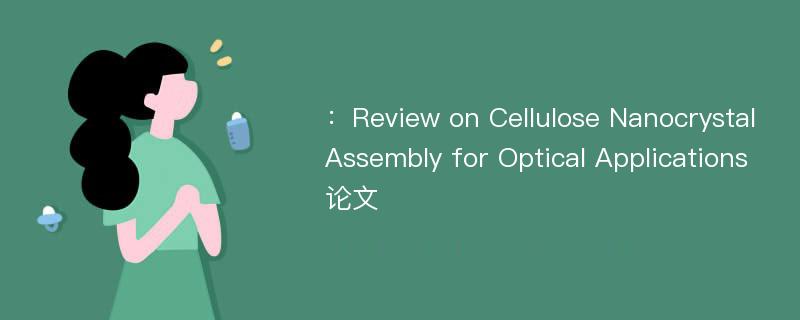
本文主要研究内容
作者(2019)在《Review on Cellulose Nanocrystal Assembly for Optical Applications》一文中研究指出:Cellulose nanocrystals(CNCs) can self-assemble in suspension to form chiral cholesteric structure of liquid crystal with unique birefringence phenomena, and the structural parameters strongly depend upon the aspect ratio, surface structure, and physicochemical properties of CNC, along with suspension media. Many attempts have been carried out to keep this cholesteric structure in solid state via removing solvent, such as slower solvent-evaporation, rapid vacuum-filtration, and spin-casting under centrifugal force. The solid-state iridescence of the cholesteric CNC arrays has been used as structural color, and showed a great potential for the coding and securing of optical information. Moreover, to promote practical applications of such structural iridescence, the cholesteric CNC arrays have been embedded into many kinds of substrates via in-situ reaction of monomers or physical blending with polymers. However, this kind of structural iridescences may lead to misreading information. The uniaxial-orientation assembly of CNC has thus been proposed via regulating external force fields of CNC self-assembly, and successfully achieved nanoparticle assembly-induced solid-state monochrome emission based on enhanced inelastic collision theory of CNC dipoles and photons. This method can eliminate the chiral arrangement of CNC and the corresponding iridescence, and the structural monochromaticity can contribute to enhancing the accuracy of optical information. Overall, the CNC can be controllably assembled as the ordered arrays in solid state and presented structural color, and support optical anti-counterfeiting strategies different from the fluorescent technologies.
Abstract
Cellulose nanocrystals(CNCs) can self-assemble in suspension to form chiral cholesteric structure of liquid crystal with unique birefringence phenomena, and the structural parameters strongly depend upon the aspect ratio, surface structure, and physicochemical properties of CNC, along with suspension media. Many attempts have been carried out to keep this cholesteric structure in solid state via removing solvent, such as slower solvent-evaporation, rapid vacuum-filtration, and spin-casting under centrifugal force. The solid-state iridescence of the cholesteric CNC arrays has been used as structural color, and showed a great potential for the coding and securing of optical information. Moreover, to promote practical applications of such structural iridescence, the cholesteric CNC arrays have been embedded into many kinds of substrates via in-situ reaction of monomers or physical blending with polymers. However, this kind of structural iridescences may lead to misreading information. The uniaxial-orientation assembly of CNC has thus been proposed via regulating external force fields of CNC self-assembly, and successfully achieved nanoparticle assembly-induced solid-state monochrome emission based on enhanced inelastic collision theory of CNC dipoles and photons. This method can eliminate the chiral arrangement of CNC and the corresponding iridescence, and the structural monochromaticity can contribute to enhancing the accuracy of optical information. Overall, the CNC can be controllably assembled as the ordered arrays in solid state and presented structural color, and support optical anti-counterfeiting strategies different from the fluorescent technologies.
论文参考文献
论文详细介绍
论文作者分别是来自Paper and Biomaterials的,发表于刊物Paper and Biomaterials2019年02期论文,是一篇关于,Paper and Biomaterials2019年02期论文的文章。本文可供学术参考使用,各位学者可以免费参考阅读下载,文章观点不代表本站观点,资料来自Paper and Biomaterials2019年02期论文网站,若本站收录的文献无意侵犯了您的著作版权,请联系我们删除。
